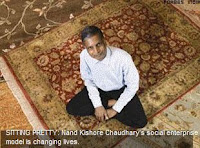
A subsequent visit to a primary health centre gave Padma a devastating shock - the child was declared irreversibly blind. He was suffering from Retinopathy of Prematurity (ROP) - the leading cause of preventable childhood blindness in India.
ROP is a condition that affects up to 47 per cent of the babies born below 2,000 grams in India. Of these, nearly 20 per cent go blind if not treated on time. Interestingly, none of these children are born with ROP. Premature babies actually go on to develop it between one to three months after birth. Strangely, even as vitamin A deficiency and corneal problems have received adequate consideration and funding from the government, retinal malfunctions that account for 22 per cent of the childhood blindness cases in India have failed to draw requisite attention from the relevant authorities.
With the Union health ministry yet to realise the seriousness of this problem, the fight against ROP is now being led by two unlikely heroes in Karnataka - Dr Anand Vinekar, a paediatric retinal surgeon armed with a laser machine and a camera the size of a 165-litre fridge on the backseat of his Qualis, and Krishna, a 25-year-old technician who has barely cleared middle school.
For the past two years, Dr Vinekar, head of Narayana Nethralaya Postgraduate Institute of Ophthalmology's department of paediatric retina, and Krishna - a lab technician trained to identify various stages of ROP with nearly 100 per cent accuracy by just looking at images - have been traversing the most backward roads of Karnataka for 13 hours a day, stopping at villages, screening newborns for ROP and surgically treating those who need it on the spot with the laser machine.
However, what's creating waves internationally is their latest project - a Tele-ROP model. This is how it works. Trained technicians visit remote villages, capture retinal images with a special portable digital wide-field camera (capable of seeing 130° of the retina with one single shot). These are then sent via email to a special server. Retinal experts sitting miles away view the images and give their diagnosis within minutes. The technician then informs the mother about ROP and gets the child treated by a Narayana Nethralaya ophthalmic surgeon.
"India has less than 300 retinal surgeons,"says Dr Vinekar. "That's why we are training common people to become technicians - those who can just look at images and detect stage one to stage five ROP, negating the requirement for a doctor. It is easy to take a retinal image, so we are training technicians to analyse the images and diagnose. Due to the massive number of babies that need to be screened, and the limited number of trained physicians, there is no other way. At present, babies born in rural areas are either never screened or screened too late for ROP, which can be prevented by timely diagnosis and appropriate treatment. That's why we are now creating self-sufficient districts - training ophthalmologists from peripheral healthcare centres to treat ROP besides having two technicians per district. Besides Karnataka , a similar project is underway in West Bengal." Till now, they have screened over 1,700 infants around a 350-km radius of the Nethralaya. Over 155 kids from neonatal centres in 18 hospitals in south Karnataka's seven districts have been treated.
The ministry has finally taken note of their efforts and through a publicprivate partnership decided to incorporate the model in India's National Rural Health Mission. Six more districts in Karnataka are now being added for the out-reach programme, which will ultimately be taken across the country. "A number of Southeast Asian and African countries are facing similar problems with ROP and have a shortage of trained ophthalmologists," Dr Vinekar says. "India has proved that a technician-driven model works. What's worse about ROP is that the retina does not look abnormal from outside till it reaches stage five when the eye looks white in the centre. The blindness is irreversible then. Till now, we have taken 100,000 images. To ensure that data is not lost via transit on the net, we have developed a specialised server where experts log in, see images and give their diagnosis. The software is now also being incorporated in an iPhone so that live images can be transferred via SMS. This will enable the iPhone to allow experts sitting anywhere to access images taken in any part of the country."
Blind spot
India is home to one fourth of the world's blind children, making it the world's blind children's capital Retinopathy of Prematurity (ROP) affects up to 47% of the babies born below 2,000 grams in India India has 24 million live births annually, of which 8.4% babies are born below 2,000 grams Of these 15-20 % will go blind if not treated in time Blindness sets in when the child is 4-6 weeks old and becomes complete before the tenth week ROP mainly affects premature infants born before 31 weeks of gestation (a full-term pregnancy has a gestation of 38-42 weeks) The smaller a baby is at birth, the more likely it is to develop ROP ROP was first diagnosed in 1942 ROP is classified in five stages, ranging from mild (stage I) to severe (stage V) Babies can be treated between stages II and III ROP occurs when abnormal blood vessels grow and spread throughout the retina. These vessels are fragile and can leak, scarring the retina and causing retinal detachment - the main cause of blindness
















